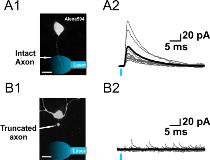Optogenetic investigation of axo-axonic inhibition in the olfactory cortex
Abstract number :
3.308
Submission category :
Late Breakers
Year :
2013
Submission ID :
1861032
Source :
www.aesnet.org
Presentation date :
12/7/2013 12:00:00 AM
Published date :
Dec 5, 2013, 06:00 AM
Authors :
X. Wang, Q. Sun
Rationale: GABAergic terminals of chandelier cells exclusively innervate axon initial segment (AIS) of excitatory neurons. However, the functional properties of these synapses and their ability to regulate seizure activity are unclear. Methods: Using an optogenetic approach, we seek to investigate on the functional properties of axo-axonic synapse (AAS) in the piriform cortex of mice, a region known to be associated with temporal lobe epilepsy. To achieve subcellular synaptic activation at AIS, we developed a novel fiber optic approach. Gramicidin-based perforated patch was employed to study the functional properties of AAS while maintaining the intracellular chloride concentration. The effect of laser activation of AAS on electrically evoked epileptiform discharges was also examined under cell-attach and whole-cell somatic recordings.Results: Under whole-cell somatic voltage-clamp recording mode, we characterized the AAS input and compared it to perisomatic input. Our results indicate that the amplitudes and kinetics (decay tau and time to peak) of synaptic potentials mediated by AAS are very similar to those of perisomatic inhibition induced in the same neurons. Under perforated patch and current-clamp, our data show that, GABA reversal potential (EGABA) is -73.6 1.2 mV at AIS and not significantly different from EGABA at soma in the same neurons (-72.8 1.1 mV). Further, both AAS and perisomatic inhibition provided robustly and transiently vetoed action potentials in a similar manner across all membrane potentials tested (-50 to -90 mV). We also demonstrated that single laser AAS activation was able to reduce the epileptiform afterdischarges by 49.2 6.5 %, similar to the activation of perisomatic innervations (50.5 6 %). Conclusions: We concluded AAS forms a unique subcellular inhibitory domain, whose functional properties are similar to perisomatic inhibition. However, AAS activation alone was sufficient to suppress epileptiform activities in vitro. Funding is provided by American Epilepsy Foundation Pre-doctoral Research Training Fellowship.
